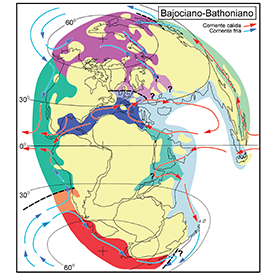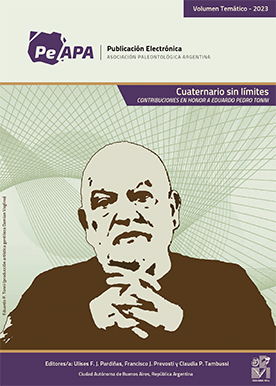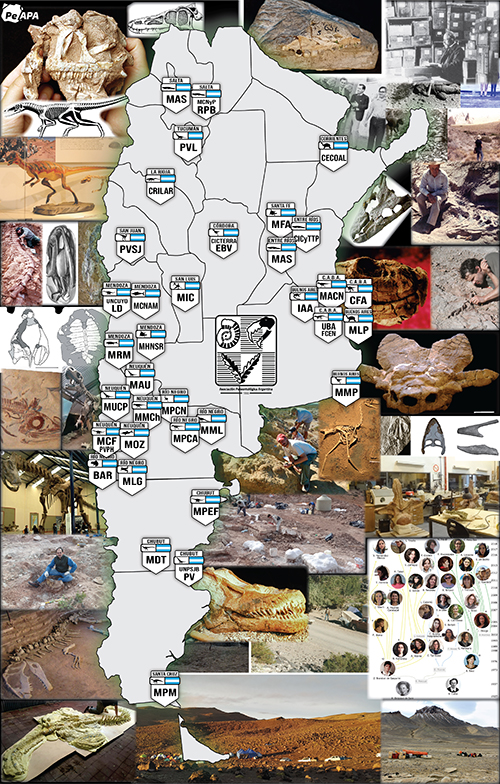REVISIÓN DE LOS BIOCOREMAS MARINOS GLOBALES DEL JURÁSICO SEGÚN LA DISTRIBUCIÓN DE LOS MOLUSCOS BIVALVOS
DOI:
https://doi.org/10.5710/PEAPA.18.10.2017.245Resumen
Resumen. Numerosos trabajos regionales o locales han propuesto el reconocimiento de unidades biogeográficas de distintos rangos (biocoremas) basadas sobre la distribución de los moluscos bivalvos para el Jurásico, pero no existía una síntesis a nivel mundial. Este trabajo es una revisión de las más significativas de esas propuestas, en un intento de lograr una síntesis de los patrones biogeográficos globales desde el Jurásico Temprano al Tardío, mientras se producían cambios sustanciales en la paleogeografía de la Tierra y los patrones de circulación oceánica como resultado de la disgregación de Pangea. Se hace también un breve análisis de la evolución en el tiempo y el espacio de cada una de las principales unidades reconocidas y de sus relaciones. Estos biocoremas pueden agruparse en tres unidades de primer orden que han tenido continuidad en el tiempo: Boreal, Tethys y Austral. Las unidades revisadas aquí han sido reconocidas y caracterizadas de forma muy heterogénea por los distintos autores, pero los criterios básicos más utilizados incluyen desde el grado de endemismo y la diversidad relativa, hasta las afinidades paleobiogeográficas de los taxones a nivel genérico. Los patrones de distribución de los bivalvos jurásicos no solamente son claves para entender cuestiones puramente biogeográficas, sino que han sido utilizados como argumento y evidencia en discusiones de índole paleogeográfica (como el establecimiento de corredores oceánicos, o patrones de circulación marina superficial), e incluso son pruebas de peso para la discusión de tópicos paleotectónicos, como la localización de terrenos desplazados y la deriva continental.
PALABRAS CLAVE: Paleobiogeografía. Jurásico. Bivalvia. Biocoremas. Provincias biogeográficas. Bipolaridad. Gradientes latitudinales.
Abstract. A REVIEW OF JURASSIC MARINE WORLDWIDE BIOCHOREMAS BASED ON THE DISTRIBUTION OF BIVALVE MOLLUSKS. Local and regional papers analyzing the distribution of Jurassic bivalves and proposing new palaeobiogeographic units of various ranks are numerous, but a worldwide synthesis was lacking. This paper is a review of those proposals with the aim to obtain a coherent synthesis of the global biogeographic patterns from Early to Late Jurassic times, when significant changes in the Earth paleogeography and oceanic circulation took place as the result of the breakup of Pangea. A brief account of the evolution in time and space of the recognized units and their relationships is also made. The biochoremas can be grouped into three first order units which had temporal continuity: Boreal, Tethys and Austral Realms. The units analysed here were recognized and characterized in very different grounds by their authors; the most commonly used criteria are degree of endemism, relative diversity and palaeobiogeographic affinities of bivalve genera. The patterns of Jurassic bivalve distribution are key to understand general biogeographic issues, but they were also used as evidence in palaeogeographic discussions (such as the establishment of seaways and changing patterns of superficial water circulation); they are even arguments in some palaeotectonic issues, such as the localization and history of displaced terranes, and continental drift.
KEY WORDS: Palaeobiogeography. Jurassic. Bivalvia. Biocoremas. Biogeographic provinces. Bipolarity. Latitudinal gradients.
Citas
Abdelhady, A.A. y Fürsich, F.T. 2015. Palaeobiogeography of the Bajocian-Oxfordian macrofauna of Gebel Maghara (North Sinai, Egypt): Implications for eustacy and basin topography. Palaeogeography, Palaeoclimatology, Palaeoecology 417: 261–273.
Aberhan, M. 1998. Paleobiogeographic Patterns of Pectinoid Bivalves and the Early Jurassic Tectonic Evolution of Western Canadian Terranes. Palaios 13: 129–148.
Aberhan, M. 1999. Terrane history of the Canadian Cordillera: estimating amounts of latitudinal displacement and rotation of Wrangellia and Stikinia. Geological Magazine 136(5): 481–492.
Aberhan, M. 2001. Bivalve palaeobiogeography and the Hispanic Corridor: time of opening and effectiveness of a proto-Atlantic seaway. Palaeogeography, Palaeoclimatology, Palaeoecology 165(3-4): 375–394.
Aberhan, M. 2002. Opening of the Hispanic Corridor and Early Jurassic bivalve biodiversity. En: J.A. Crame y A.W. Owen (Eds.), Paleobiogeography and Biodiversity Change: the Ordovician and Mesozoic-Cenozoic Radiation. Geological Society Special Publication 194: 127–139.
Aberhan, M. y Fürsich, F.T. 1997. Diversity analysis of lower Jurassic bivalves of the Andean Basin and the Pliensbachian/Toarcian mass extinction. Lethaia 29: 181–195.
Aberhan, M. y Fürsich, F.T. 2000. Mass origination versus mass extinction: the biological contribution to the Pliensbachian-Toarcian extinction event. Journal of the Geological Society, London 157: 55–60.
Aberhan, M. y Pálfy, J. 1996. A low oxygen tolerant East Pacific flat clam (Posidonotis semiplicata) from the Lower Jurassic of the Canadian Cordillera. Canadian Journal of Earth Sciences 33: 993–1006.
Accorsi Benini, C. 1985. The large Liassic bivalves: symbiosis or longevity. Palaeogeography, Palaeoclimatology, Palaeoecology 52: 21–33.
Accorsi Benini, C. y Broglio Loriga, C. 1977. Lithiotis Gümbel, 1871 e Cochlearites Reis, 1903, 1° revisione morfologica e tassonomica. Bollettino della Società Paleontologica Italiana 16(1): 15–60.
Alberti, M., Fürsich, F.T. y Pandey, D. 2012. The Oxfordian stable isotope record (δ18O, δ13C) of belemnites, brachiopods, and oysters from the Kachchh Basin (western India) and its potential for palaeoecologic, palaeoclimatic, and palaeogeographic reconstructions. Palaeogeography, Palaeoclimatology, Palaeoecology 344-345: 49–68.
Arias, C. 2008. Palaeoceanography and biogeography in the Early Jurassic Panthalassa and Tethys Oceans. Gondwana Research 14: 306–315.
Arkell, W.J. 1956. Jurassic Geology of the World. Oliver and Boyd Ltd, Edinburgh-London. 806 p.
Bosellini, A. 1972. Paleoecologia dei Calcari a “Lithiotis” (Giurassico inferiore, Prealpi Venete). Rivista Italiana di Paleontologia e Stratigrafia 78: 49–56.
Broglio Loriga, C. y Neri, C. 1976. Aspetti paleobiologici e palaeogeografici della facies a ‘‘Lithiotis’’ (Giurese inf.). Rivista Italiana di Paleontologia e Stratigrafia 82: 651–705.
Buser, S. y Debeljak, I. 1996. Lower Jurassic beds with bivalves in south Slovenia. Geologija 37/38: 23–62.
Caswell, B.A. y Coe, A.L. 2013. Primary productivity controls on opportunistic bivalves during Early Jurassic oceanic deoxygenation. Geology 41: 1163–1166.
Cecca F. y Westermann, G.E.G. 2003. Towards a guide to palaeobiogeographic classification. Palaeogeography, Palaeoclimatology, Palaeoecology 201: 179–181.
Challinor, A.B. 1991. Belemnite succession and faunal provinces in the southwest Pacific, and the belemnites of Gondwana. Journal of Australian Geology and Geophysics 12: 301–325.
Chen Jinhua. 1982. [Mesozoic transgressions, regressions and bivalve provinces in China]. Acta Geologica Sinica 21(4): 334–346 [en Chino].
Chinzei, K. 1982. Morphological and structural adaptations to soft substrates in the Early Jurassic monomyarians Lithiotis and Cochlearites. Lethaia 15: 179–197.
Crame J.A. 1981. The occurrence of Anopaea (Bivalvia: Inoceramidae) in the Antarctic Peninsula. Journal on Molluscan Studies 47: 206–219.
Crame, J.A. 1986. Late Mesozoic bipolar bivalve faunas. Geological Magazine 123(6): 611–618.
Crame J.A. 1987. Late Mesozoic bivalve biogeography of Antarctica. Proceedings of the Sixth Gondwana Symposium (Columbus, Ohio): 93–102.
Crame, J.A. 1993. Bipolar molluscs and their evolutionary implications. Journal of Biogeography 20: 145–161.
Crame J.A. 1996. Evolution of high-latitude molluscan faunas. En: J.D. Taylor (Ed.), Origin and Evolutionary Radiation of the Mollusca. Oxford University Press, Oxford, p. 119–131.
Crame J.A. 2000. Evolution of taxonomic diversity gradients in the marine realm: evidence from the composition of Recent bivalve faunas. Paleobiology 26:188–214.
Crame J.A. 2002. Evolution of taxonomic diversity gradients in the marine realm: a comparison of Late Jurassic and Recent bivalve faunas. Paleobiology 28(2):184–207.
Damborenea, S.E. 1987. Early Jurassic Bivalvia of Argenti¬na. Part II: Superfamilies Pteriacea, Buchiacea and part of Pectinacea. Palaeonto¬gra¬phica A 99(4-6): 113–216.
Damborenea, S.E. 1989. El género Posidonotis Losacco (Bivalvia, Jurá¬sico inferior): su distribución estratigrá¬fica y paleogeográfica. 4° Congreso Argentino de Paleontología y Bioestratigrafía (Mendoza, 1986), Actas 4: 45–51.
Damborenea, S.E. 1990. Middle Jurassic inoceramids from Argentina. Journal of Paleontology 64(5): 736–759.
Damborenea, S.E. 1993. Early Jurassic South American pectinaceans and circum-Pacific palaeobiogeography. Palaeogeography, Palaeoclimatology, Palaeoecology 100(1-2): 109–123.
Damborenea, S.E. 1996. Palaeobiogeography of Early Jurassic bivalves along the southeastern Pacific margin. 13º Congreso Geológico Argentino y 3º Congreso de Exploración de Hidrocarburos (Buenos Aires), Actas 5: 151–167.
Damborenea, S.E. 2000. Hispanic Corridor: its evolution and the biogeography of bivalve molluscs. En: R.L. Hall y P.L. Smith (Eds.), Advances in Jurassic Research 2000, GeoResearch Forum 6: 369–380.
Damborenea, S.E. 2002a. Jurassic evolution of Southern Hemisphere marine palaeobiogeographic units based on benthonic bivalves. Géobios Mémoir Special 24: 51–71.
Damborenea, S.E. 2002b. Unidades paleobiogeográficas marinas jurásicas basadas sobre moluscos bivalvos: una visión desde el Hemisferio Sur. Anales de la Academia Nacional de Ciencias Exactas, Físicas y Naturales (Buenos Aires) 53: 141–160.
Damborenea, S.E. y Echevarría, J. 2015. Palaeolatitudinal gradients along the southeastern Palaeo-Pacific margin and the distribution of Early Jurassic bivalves. Volumina Jurassica 13(1): 3–16.
Damborenea, S.E. y Manceñido, M.O. 1979. On the palaeogeographical distribution of the pectinid genus Weyla (Bivalvia, Lower Jurassic). Palaeogeography, Palaeoclimatology, Palaeoecology 27(1/2): 85–102.
Damborenea, S.E. y Manceñido, M.O. 1988. Weyla: semblanza de un bivalvo Jurásico andino. 5° Congreso Geológico Chileno (Santiago de Chile), Actas 2: C13–C25.
Damborenea, S.E., Echevarría, J. y Ros-Franch, S. 2013. Southern hemisphere palaeobiogeography of Triassic-Jurassic marine bivalves. SpringerBriefs in Earth System Sciences VIII, 139 p.
Damborenea, S.E., Echevarría, J. y Ros-Franch, S. 2017. Biotic recovery after the end-Triassic extinction event: evidence from marine bivalves of the Neuquén Basin, Argentina. Palaeogeography, Palaeoclimatology, Palaeoecology. doi: 10.1016/j.palaeo.2017.08.025.
Diener, C. 1916. Die marinen Reiche der Trias-Periode. Denkschriften, Akademie der Wissenschaften, Wien 92: 405–549.
Dresnay, R. du. 1977. Le milieu récifal fossile du Jurassique inférieur (Lias) dans le domaine des Chaînes atlasiques du Maroc. France, Bureau de Recherches Géologiques et Minières 89: 296–312.
Fraser, N.M., Bottjer, D.J. y Fischer, A.G. 2004. Dissecting “Lithiotis” bivalves: implications for the early Jurassic reef eclipse. Palaios 19: 51–67.
Geyer, O.F. 1977. Die ‘‘Lithiotis-Kalke’’ im Bereich der unterjurassischen Tethys. Neues Jahrbuch für Geologie und Paläontologie, Abh. 153: 304–340.
Golonka, J. 2002. Plate-tectonic maps of the Phanerozoic. En: W. Kiessling, E. Flüguel y J. Golonka (Eds.), Phanerozoic Reef Patterns. SEPM Special Publication 72: 21–75.
Golonka, J. y Krobicki, M. 2010. Paleozoic and Mesozoic evolution of the Peri-Gondwanan plates – SE Asia perspective. 6th Symposium of the International Correlation Programme Project 516 (Kuala Lumpur, Malaysia): 34–35.
Grant-Mackie, J.A., Aita, Y., Balme, B.E., Campbell, H.J., Challinor, A.B., MacFarlan, D.A.B., Molnar, R.E., Stevens, G.R. y Thulborn, R.A. 2000. Jurassic palaeobiogeography of Australasia. En: A.J. Wright, G.C. Young, J.A. Talent y J.R. Laurie (Eds.), Palaeobiogeography of Australasian faunas and floras. Memoir of the Association of Australasian Palaeontologists 23: 311–353.
Hallam, A. 1967. The bearing of certain palaeozoogeographic data on continental drift. Palaeogeography, Palaeoclimatology, Palaeoecology 3:201–241.
Hallam, A. 1969. Faunal realms and facies in the Jurassic. Palaeontology 12(1): 1–18.
Hallam, A. 1971. Provinciality in Jurassic faunas in relation to facies and palaeogeography. En: F.A. Middlemiss, P.F. Rawson y G. Newall (Eds.), Faunal provinces in space and time. Geological Journal Special Issue 4: 129–152.
Hallam, A. 1975. Jurassic environments. Cambridge University Press. Cambridge. 269 p.
Hallam, A. 1977. Jurassic bivalve biogeography. Paleobiology 3(1): 58–73.
Hallam, A. 1981. The end-Triassic bivalve extinction event. Palaeogeography, Palaeoclimatology, Palaeoecology 35: 1–44.
Hallam, A. 1983. Early and mid-Jurassic molluscan biogeography and the establishement of the central Atlantic seaway. Palaeogeography, Palaeoclimatology, Palaeoecology 43: 181–193.
Hallam, A., 1996. Recovery of the marine fauna in Europe after the end-Triassic and early Toarcian mass extinctions. En: M.B. Hart (Ed.), Biotic Recovery from Mass Extinction Events. Geological Society Special Publication 102: 231–236.
Hautmann, M., Stiller, F., Cai, H. y Sha, J. 2008. Extinction-recovery pattern of level-bottom faunas across the Triassic-Jurassic boundary in Tibet: implications for potential killing mechanisms. Palaios 23: 711–718.
Hayami, I. 1984. Jurassic Marine Bivalve Faunas and Biogeography in Southeast Asia. Geology and Palaeontology of Southeast Asia 25: 229–237.
Hayami, I. 1987. Geohistorical background of Wallace’s Line and Jurassic Marine biogeography. En: A. Taira y M. Tashiro (Eds.), Historical biogeography and plate Tectonic evolution of Japan and Eastern Asia. Terra Scientific Publications Co., Tokyo, p. 111–133.
Hayami, I. 1989. Outlook of the Post-Paleozoic Historical Biogeography of Pectinids in the Western Pacific Region. The University Museum, The University of Tokyo, Nature and Culture 1: 3–25.
Hayami, I. 1990. Geographic Distribution of Jurassic Faunas in Eastern Asia. En: K. Ichikawa, S. Mizutani, I. Hara, S. Hada y A. Yao (Eds.), Pre-Cretaceous Terranes of Japan. Publication of IGCP Project 224, Osaka, p. 361–369.
Heinze, M. 1996. Paläobiogeographie jurassischer Muschelfaunen: Beziehungen zwischen Süd- und Nordrand der Tethys. Paläontologische Zeitschrift 70: 97–128.
Hillebrandt, A. von. 1971. Der Jura in der chilenisch-argentinischen Hochkordillere (25° bis 32°30´ S). Münstersche Forshungen zur Heologie und Paläontologie 20/21: 63–87.
Imlay, R.W. 1965. Jurassic marine faunal differentiation in North America. Journal of Paleontology 39(5): 1023–1038.
Jeletzky J.A. 1983. Macroinvertebrate paleontology, biochronology, and paleoenvironments of Lower Cretaceous and upper Jurassic rocks, Deep Sea Drilling Hole 511, eastern Falkland Plateau. Initial Reports of the Deep Sea Drilling Project 71: 951–975.
Kauffman, E.G. 1973. Cretaceous Bivalvia. En: A. Hallam (Ed.), Atlas of Palaeobiogeography. Elsevier, Amsterdam, p. 353–383.
Kelly, S.R.A. 1995. New trigonioid bivalves from the Early Jurassic to earliest Cretaceous of the Antarctic Peninsula region: systematics and austral paleobiogeography. Journal of Paleontology 69(1): 66–84.
Kelly, S.R.A. y Doyle, P. 1991. The bivalve Aulacomyella from the Early Tithonian (Late Jurassic) of Antarctica. Antarctic Science 3(1): 97–107.
Kiessling, W., Pandey, D.K., Schemm-Gregory, M., Mewis, H. y Aberhan, M. 2011. Marine benthic invertebrates from the Upper Jurassic of northern Ethiopia and their biogeographic affinities. Journal of African Earth Sciences 59: 195–214.
Krobicki, M. y Golonka, J. 2009. Palaeobiogeography of early Jurassic Lithiotis-type bivalve buildups as recovery effect after Triassic/Jurassic mass extinction and their connection with Asian palaeogeography. Acta Geoscientica Sinica 30 suppl. 1: 30–33.
Krobicki, M. y Golonka, J. 2014. Palaeobiogeographical distribution of the Early Jurassic Lithiotis-type bivalves versus Lhasa Block history. En: C. Montomoli et al. (Eds.), Proceedings of the 29th Himalaya-Karakoram-Tiber Workshop (Lucca, Italy), Journal of Himalayan Earth Sciences Special Volume: 88–89.
Lee, C.W. 1983. Bivalve mounds and reefs of the Central High Atlas, Morocco. Palaeogeography, Palaeoclimatology, Palaeoecology 43: 153–168.
Leinfelder, R.R. 1993. Upper Jurassic reef types and controlling factors. Profil 5: 1–45.
Leinfelder, R.R., Schmid, D.U., Nose, M. y Werner, W. 2002. Jurassic reef patters – The expression of a changing globe. En: W. Kiessling, E. Flüguel y J. Golonka (Eds.), Phanerozoic Reef Patterns. SEPM Special Publication 72: 465-520.
Liu Chunlian. 1995. Jurassic bivalve palaeobiogeography of the Proto-Atlantic and the application of multivariate analysis methods in palaeobiogeography. Beringeria 16: 3–123.
Liu Chunlian, Heinze, M. y Fürsich, F.T. 1998. Bivalve provinces in the Proto-Atlantic and along the southern margin of the Tethys in the Jurassic. Palaeogeography, Palaeoclimatology, Palaeoecology 137: 127–151.
Makridin, V.P. 1973. The principles of discrimination and nomenclature of subdivisions in the paleogeographic zoning of marine basins. Paleontological Journal 7: 27–131.
Marwick, J. 1953. Faunal migrations in New Zealand seas during the Triassic and Jurassic. New Zealand Journal of Science and Technology B 34(5): 317–321.
McRoberts, C.A., Newton, C.R. y Allasinaz, A. 1995. End-Triassic bivalve extinction: Lombardian Alps, Italy. Historical Biology 9: 297–317.
Nauss, A.L. y Smith, P.L. 1988. Lithiotis (Bivalvia) bioherms in the lower Jurassic of East-central Oregon, USA. Palaeogeography, Palaeoclimatology, Palaeoecology 65: 253–268.
Neumayr, M. 1885. Die geographische Verbreitung der Juraformation. Denkschriften der kaiserlichen Akademie der Wissenschaften, Mathematisch-naturwississenschaftliche Classe, Wien 50: 57–142.
Newton, C.R. 1988. Significance of “Tethyan” fossils in the American Cordillera. Science 242(4877): 385–391.
Niu Yazhou, Jiang Baoyu y Huang Hao. 2011. Triassic marine biogeography constrains the palaeogeographic reconstruction of Tibet and adjacent areas. Palaeogeography, Palaeoclimatology, Palaeoecology 306: 169–175.
Oschmann, W. 1993. Environmental oxygen fluctuations and the adaptive response of marine benthic organisms. Journal of the Geological Society (London) 150: 187–191.
Parrish, J.T. 1992. Jurassic climate and oceanography of the Pacific region. En: G.E.G. Westermann (Ed.), The Jurassic of the Circum-Pacific. Cambridge University Press, Cambridge, p. 365–379.
Posenato, R. y Masetti, D. 2012. Environmental control and dynamics of Lower Jurassic bivalve build-ups in the Trento Platform (Southern Alps, Italy). Palaeogeography, Palaeoclimatology, Palaeoecology 361–362: 1–13.
Posenato, R., Bassi, D. y Avanzini, M. 2013. Bivalve pavements from shallow-water black-shales in the Early Jurassic of northern Italy: a record of salinity- and oxygen-depleted environmental dynamics. Palaeogeography, Palaeoclimatology, Palaeoecology 369: 262–271.
Riccardi, A.C. 1977. Berriasian invertebrate fauna from the Springhill Formation of Southern Patagonia. Neues Jahrbuch für Geologie und Paläontologie, Abhandlung 155: 216–252.
Riccardi, A. C. 1991. Jurassic and Cretaceous marine connections between the Southeast Pacific and Tethys. Palaeogeography, Palaeoclimatology, Palaeoecology 87: 155–189.
Rivas, P., Aguirre, J. y Braga, J.C. 1997. Entolium beds: Hiatal Shell concentrations in starved pelagic settings (Middle Liassic, SE Spain). Eclogae Geologica Helvetica 90: 293–301.
Ros, S., de Renzi, M., Damborenea, S.E. y Márquez-Aliaga, A. 2011. Coping between Crises: Early Triassic-Early Jurassic Bivalve Diversity Dynamics. Palaeogeography, Palaeoclimatology, Palaeoecology 311(3-4): 184–199.
Ros, S., de Renzi, M., Damborenea, S.E. y Márquez-Aliaga, A. 2012. Early Triassic-Early Jurassic Bivalve Diversity Dynamics. En: J. Carter et al. (Eds.), Treatise on Invertebrate Paleontology. Part N, Revised, Volume 1, Chapter 25. Bivalvia. Paleontological Institute. The University of Kansas. Treatise Online 39: 1–19.
Ros-Franch, S., Damborenea, S.E., Al-Suwaidi, A., Hesselbo, S.P., Jenkyns, H.C., Manceñido, M.O. y Riccardi, A.C. 2014. Relationship between anoxic conditions and size in Posidonotis (Bivalvia) from the Lower Jurassic of the Neuquén Basin, Argentina. 4th International Palaeontological Congress (Mendoza, Argentina), Abstract Volume: 800.
Savazzi, E. 1996. Preserved ligament in the Jurassic bivalve Lithiotis: adaptive and evolutionary significance. Palaeogeography, Palaeoclimatology, Palaeoecology 120: 281– 289.
Sha Jingeng. 1996. Antitropicality of the Mesozoic Bivalves. En: Z.H. Pang et al. (Eds.): Advances in Solid Earth Sciences. Science Press, Peking, p. 90–98.
Sha Jingeng. 2002. Hispanic Corridor formed as early as Hettangian: On the basis of bivalve fossils. Chinese Science Bulletin 47(5): 414–417.
Shurygin, B.N. 2005. Biogeografiya, fatsii i stratigrafiya nizhnej i srednej Yury Sibiri po dvustvorchatym mollyuskan [Lower and Middle Jurassic biogeography, facies and stratigraphy in Siberia based on bivalve mollusks]. Trofimuk United Institute of Geology, Geophysics and Mineralogy; Institute of Petroleum Geology. Academic Publishing House “Geo”, Novosibirsk. 156 p.
Smith, P.L. 1989. Paleobiogeography and Plate Tectonics. Geoscience Canada 15: 261–279.
Smith P.L. y Tipper, H.W. 1986. Plate tectonics and paleobiogeography: Early Jurassic (Pliensbachian) endemism and diversity. Palaios 1: 399–412.
Stanley jr., G.D. 1997. Evolution of reefs of the Mesozoic. Proceedings of the 8th International Coral Reef Symposium 2: 1657–1662.
Stevens, G.R. 1967. Upper Jurassic fossils from Ellsworth Land, West Antarctica, and notes on Upper Jurassic biogeography of the South Pacific region. New Zealand Journal of Geology and Geophysics 10(3): 345–393.
Stevens, G.R. 1977. Mesozoic biogeography of the South-West Pacific and its relationship to plate tectonics. International Symposium on the Geodynamics of the S.W. Pacific. Ed. Technip, Paris, p. 309–326.
Stevens, G.R. 1980. Southwest Pacific faunal palaeobiogeography in Mesozoic and Cenozoic times: a review. Palaeogeography, Palaeoclimatology, Palaeo¬ecology 31(2-4): 153–196.
Stevens, G.R. 1990. The influences of palaeogeography, tectonism and eustasy on faunal development in the Jurassic of New Zealand. Atti del Secondo Convegno Internazionale Fossili, Evoluzione, Ambiente (Pergola 1987), p. 441–457.
Westermann, G.E.G. 2000a. Biochore classification and nomenclature in paleobiogeography: an attempt at order. Palaeogeography, Palaeoclimatology, Palaeoecology 158: 1–13.
Westermann, G.E.G. 2000b. The marine faunal realms of the Mesozoic: review and revision under the new guidelines for biogeographic classification and nomenclature. Palaeogeography, Palaeoclimatology, Palaeoecology 163: 49–68.
Wignall, P.B. 1990. Observations on the evolution and classification of dysaerobic communities. En: Miller, W. (ed.), Paleocommunity temporal dynamics: the long-term development of multispecies assemblies. Paleontological Society Special Publication 5: 99–111.
Wignall, P.B. y Bond, D.P.G. 2008. The end-Triassic and Early Toarcian mass extinction records in the British Isles. Proceedings of the Geologists´ Association 119: 73–84.
Yin Jia-run. y Wan Xiao-qiao. 1998. Discovery of the Early Jurassic Lithiotis (Bivalvia) bioherm in Tethys-Himalaya and its migration. Acta Palaeontologica Sinica 37: 253–256.

Descargas
Publicado
Número
Sección
Licencia
Derechos de autor 2017 Publicación Electrónica de la Asociación Paleontológica Argentina

Esta obra está bajo una licencia internacional Creative Commons Atribución-SinDerivadas 4.0.

Los/las autores/as conservan los derechos de autor/a y garantizan a la revista el derecho de ser la primera publicación del trabajo licenciado bajo una licencia CC Attribution-NonCommercial 4.0 que permite a otros/as compartir el trabajo con el reconocimiento de la autoría y de la publicación inicial en esta revista.






















